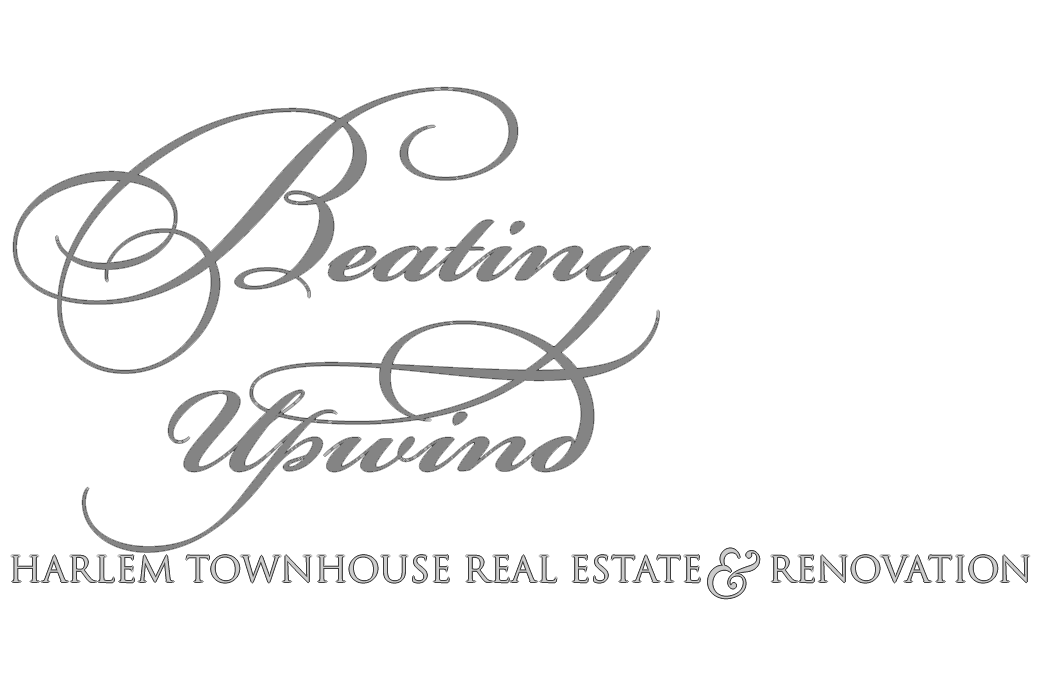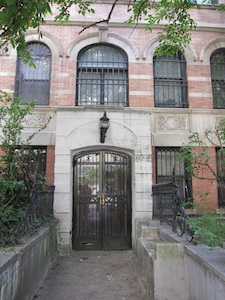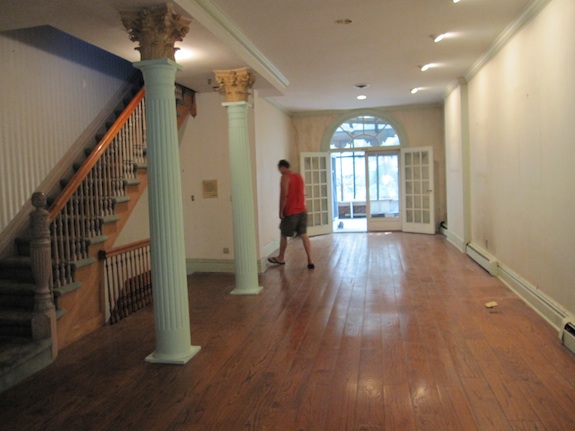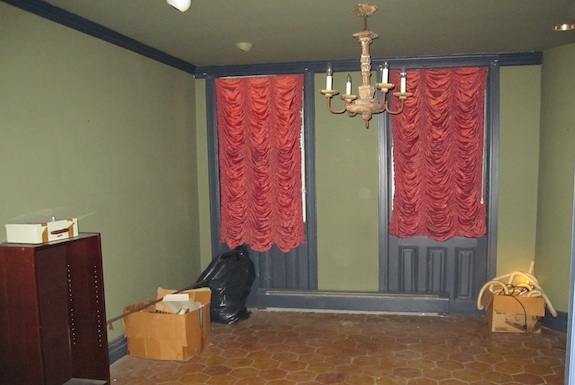Yesterday and today have been busy days… Yesterday the bank’s surveyor came by and we had to get him into the back yard (easier said than done). Today we had two appointments – one with the bank’s appraiser who is tasked with figuring out the future value of the house after renovations. And the second appointment was with a DOB building inspector to get our stop work order lifted.
In preparation for the appraiser I shelled out $70 for a Property Shark membership and stayed up late last night looking at the numbers. Banks have reputations for getting the least expensive appraiser – often ones who have no experience with Manhattan real estate. Even people who understand Manhattan real estate can get tripped up with Harlem townhouses – you have ones selling for $300,000 and others for $2 million and the official square footage is sometimes right and sometimes completely wrong. I figured I’d give the appraiser my own list of comps to reduce their chance of getting it wrong and messing up our mortgage. So here’s what I found…
| Square Feet | $/Sq. Ft. | ||||||
| Address | Date | Price | Official | Actual | Official | Actual | Class |
| 168 W 123 | 03-Mar-10 | $530,000 | 3,600 | 4,500 | $147 | $118 | C4 |
| 136 W 123 | 19-Nov-10 | $595,000 | 2,652 | 3,640 | $224 | $163 | C0 |
| 139 W 123 | 30-Nov-10 | $540,000 | 3,120 | 4,160 | $173 | $130 | S5 |
| 124 W 123 | 19-Jan-11 | $309,000 | 2,115 | 3,264 | $146 | $95 | C3 |
| 124 W 123 | 1-Mar-11 | $535,730 | 2,115 | 3,264 | $253 | $164 | C3 |
| 239 W 123 | 15-Sep-10 | $495,000 | 2,499 | 3,400 | $198 | $146 | C5 |
| 115 W 120 | 13-Aug-10 | $1,975,000 | 3,000 | 4,480 | $658 | $441 | B9 |
| 148 W 120 | 05-Nov-10 | $1,525,000 | 3,380 | 3,468 | $451 | $440 | B9 |
| 246 Lenox | 09-Dec-10 | $1,150,000 | 5,368 | 7,040 | $214 | $163 | C5 |
| 260 W 121 | 20-Sep-10 | $1,100,000 | 2,808 | 3,600 | $392 | $306 | C5 |
| 22 W 123 | 16-Dec-10 | $395,000 | 2,484 | 3,200 | $159 | $123 | C5 |
| 18 W 123 | 28-Oct-10 | $600,000 | 2,484 | 3,200 | $242 | $188 | C5 |
| 208 Lenox | 08-Dec-10 | $825,000 | 3,882 | 4,482 | $213 | $184 | C5 |
| 183 Lenox | 19-Aug-10 | $795,049 | 4,162 | 6,555 | $191 | $121 | C5 |
| 108 W 119 | 27-Aug-10 | $960,234 | 3,969 | 4,392 | $242 | $219 | C0 |
| 120 W 127 | 08-Oct-10 | $300,000 | 2,697 | 4,284 | $111 | $70 | C5 |
| 118 W 127 | 08-Oct-10 | $300,000 | 2,697 | 4,352 | $111 | $69 | C5 |
| 19 W 120 | 30-Jul-10 | $1,800,000 | 4,680 | 4,400 | $385 | $409 | B9 |
| 140 W 118 | 23-Nov-10 | $1,180,000 | 3,808 | 3,808 | $310 | $310 | B9 |
| 57 W 119 | 14-Sep-10 | $1,750,000 | 3,536 | 3,536 | $495 | $495 | B3 |
| 64 W 119 | 06-Jan-11 | $1,500,000 | 2,700 | 3,536 | $556 | $424 | C0 |
| 146 W 130 | 28-Sep-10 | $889,500 | 3,861 | 4,680 | $230 | $190 | C0 |
| 140 W 130 | 17-Nov-10 | $490,000 | 3,332 | 3,910 | $147 | $25 | C5 |
| 99 Morningside | 28-Dec-10 | $975,000 | 4,226 | 5,850 | $231 | $167 | C2 |
| 11 E 127 | 23-Dec-10 | $1,175,000 | 4,380 | 3,201 | $268 | $367 | C0 |
| 152 W 132 | 24-Jan-11 | $510,000 | 2,199 | 2,880 | $232 | $177 | C3 |
| 2087 5th | 23-Dec-10 | $ 2,075,000 | 4,960 | 6,600 | $418 | $314 | C2 |
| 233 W 113 | 19-Jan-11 | $1,350,000 | 2,464 | 3,200 | $548 | $422 | B3 |
There were more columns on my spreadsheet, but they didn’t all fit. The places are ordered by distance from our place. There are a few things to note…
First, the ones that are struck through are foreclosures – their amounts aren’t real sales amounts, they’re the amounts that were due on the mortgages. There may be foreclosures that aren’t struck through – I didn’t check extensively.
The next thing to note is the ‘building class’ column. Class B buildings are 1 and 2 family. “C0” buildings are 3 family. C2 is 5 or 6 family. C4s (like ours) are old law tenements. And C5s are rooming houses. (C4 and C5 are collectively SROs). The one S5 was an old union lodge.
You would think that 3 family homes would sell well since there’s lots of rental income to offset expenses, but taxes on them are still low, but that’s not the case. As you can see Class B buildings (2 family) consistently have much higher prices (I’ve colored them dark red). A while back Harlem Bespoke made a big of a deal that the $2 million ceiling had been broken with the sale of 2087 5th Avenue, but it’s a 5 or 6 family building. That’s more of a rental building than a typical townhouse, so I wouldn’t say the ceiling has been broken at all – it’s still very much in tact.
The other thing to note is that shells can still be picked up for under $150/sq. ft. and after rehab they’re worth about $450/sq. ft. If you do a nice, but not extravagant job rehab will cost about $200/sq. ft., so you’ll net $100/sq. ft. in profit (on paper at least). If you can put up with 2 years of chaos, shells are still an excellent investment.
As it turns out I didn’t really need to do the cheat sheet for the appraiser. When I showed him what I had done he pointed to the Class B prices and said he had seen those and that was the ballpark he was considering going into our meeting. So it looks like we’re safe on our appraisal. The bank needs us to appraise at or above $1.35M and it looks like he’ll put our future value somewhere between $1.5M and $2.0M.




